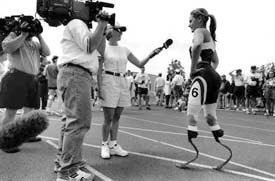Abstract
Ten years ago, as the result of a recurrent cancer, my left leg (quite literally by then 'a drag') was amputated high above the knee. Six months or so after this operation, I was ready for my first prosthetic leg and began to learn to walk again. Thus, for me, there is a certain scandal in the recent rush by cultural theorists to embrace 'the prosthetic' as metaphor -- and not because I find such metaphorical usage offensive in some facile sense that privileges "authentic" over 'discursive' experience. Rather, the prosthetic as metaphor is scandalous because it is too often less imaginatively expansive than it is reductive and less complex and productive in use than is the prosthetic in its mundane context. Perhaps, however, the prosthetic metaphor is most scandalous because it far too quickly mobilizes attention to (and fascination with) artificial and 'post-human' body parts in the service of a discourse always located elsewhere-displacing the prosthetic rather than living it first on its own quite extraordinary premises. As a consequence, 'the prosthetic 'has become a fetishized but 'unfleshed out' catchword -- a vague and 'floating signifier' -- for contemporary critical discourse on technoculture.
Since I am, shall we say, particularly 'well equipped' to do so, my talk will both critique and redress this metaphorical displacement of the prosthetic through what might be called a 'phenomenological tropology' -- that is, a thick description of the prosthetic both as it is imaginatively (and rhetorically) 'figured' through representation and as it is imaginatively lived and 'figured' as a material condition of existence. First, I focus on debates around the use and misuse of the prosthetic as metaphor with particular attention to distinctions of relation expressed in the tropological figures of metaphor, metonymy, and synecdoche. Then, I turn (autobiographically) to a more materialist, but no less figural, description of the prosthetic as a technological object and a lived experience. Finally, I address the figural and material practice and polymorphous play of Aimee Mullins-a double amputee model, athlete, and actress, whose many prosthetic legs dance both figurally and materially to a complex choreography that oversteps the bounds of the current 'prosthetic imagination.'"
Linda Williams, Prof. of Rhetoric and Film Studies, will introduce Prof. Sobchack
Bio
Vivian Sobchack is Professor of Critical Studies in the Department of Film, Television and Digital Media and Associate Dean of the School of Theater, Film and Television at the University of California, Los Angeles. She was the first woman elected president of the Society for Cinema and Media Studies and now sits on the Board of Directors of the American Film Institute. Her work focuses on film and media studies and cultural studies, with an emphasis on the phenomenology of technologically-mediated perception and the philosophy of language. Her essays have appeared in Quarterly Review of Film and Video, Artforum International, Camera Obscura, Film Quarterly, Representations, South Atlantic Quarterly, Body & Society, and History and Theory. She has edited two anthologies: The Persistence of History: Cinema, Television and the Modern Event and Meta-Morphing: Visual Transformation and the Culture of Quick Change. Her own books include Screening Space: The American Science Fiction Film, The Address of the Eye: A Phenomenology of Film Experience, and the shortly forthcoming Carnal Thoughts: Embodiment and Moving Image Culture.
-- As of 3/15/04
Updated Bio
Vivian Sobchack is Professor of Critical Studies in the Department of Film, Television and Digital Media and former Associate Dean of the School of Theater, Film and Television at the University of California, Los Angeles. She was the first woman elected president of the Society for Cinema and Media Studies and now sits on the Board of Directors of the American Film Institute. Her work focuses on film and media studies and cultural studies, with an emphasis on the phenomenology of technologically-mediated perception and the philosophy of language. Her essays have appeared in Film Comment, Quarterly Review of Film and Video, Camera Obscura, Film Quarterly, Representations, South Atlantic Quarterly, Body & Society, and History and Theory. She has edited two anthologies: The Persistence of History: Cinema, Television and the Modern Event and Meta-Morphing: Visual Transformation and the Culture of Quick Change. Her own books include Screening Space: The American Science Fiction Film, The Address of the Eye: A Phenomenology of Film Experience, and Carnal Thoughts: Embodiment and Moving Image Culture.
-- As of 1/7/07
